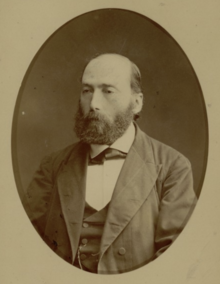Eliezer Isaac Schapira
Eliezer Isaac Schapira | |
|---|---|
 Portrait by Constantin Shapiro | |
| Born | 6 November 1835 Sereje, Suwałki Governorate, Congress Poland |
| Died | March 1915 (aged 79) Warsaw, Congress Poland |
| Pen name | Ish (אי״ש)[1] |
| Language | Hebrew |
| Literary movement | Haskalah |
Eliezer Isaac Schapira (Template:Lang-he; 6 November 1835 – March 1915) was a Jewish Polish writer, translator, and publisher.
Biography
Eliezer Isaac Schapira was born in 1835 in Sereje, Suwałki Governorate, and studied at the yeshiva of Sejny before moving to Augustów to study with his uncle, a rabbi in that city. Under the influence of his relative T. P. Schapira, he became a Hebrew teacher and a proponent of the Haskalah.[2]
In 1874, Schapira settled in Warsaw, where he opened the first publishing house for children's and young people's Hebrew literature.[3] He would become the main publisher and distributor of the works of Judah Leib Gordon.[4] He meanwhile contributed his own articles and translations to Ha-Maggid, Ha-Tsfira, Ha-Melitz, Ha-Yom, and Ha-Asif,[2] and for a time edited the periodical Ha-Boker Or.[5]
Selected publications
- Mikhtavim ba-sefer. Warsaw: Y. Goldman. 1871.
- Meged yeraḥim. Vol. 1–2. Warsaw: Y. Goldman. 1871. Collection of translated stories.[3]
- Bet ha-otsar. Vol. 1–2. Warsaw: Y. Goldman. 1875.
- Yad ḥarutsim. Warsaw: A. Ginz. 1879.
- Reshimat sifre Haskalah. Warsaw: Ḥ. Kelter. 1883.
- Ha-podeh u-matsil. Warsaw. 1885.
{{cite book}}: CS1 maint: location missing publisher (link) Translation of Salomon Kohn's novel Gallerie der Sippurim.[6]
References
| Archives at | ||||
|---|---|---|---|---|
|
||||
| How to use archival material |
- ^ Davidson, Israel (1907). Parody in Jewish Literature. Columbia University Press. p. 243.
- ^ a b Alexandroni, Yaʿakov, ed. (1966). Sefer yizkor li-ḳehilat Ogusṭov ṿeha-sevivah [Augustów Memorial Book] (in Hebrew). Tel-Aviv: Irgun yotsʾe Ogusṭov ṿeha-sevivah be-Yiśrẚel. pp. 258–259.
- ^ a b "Children's Literature". Encyclopaedia Judaica. Vol. 5. Jerusalem. 1972. p. 432.
{{cite encyclopedia}}: CS1 maint: location missing publisher (link) - ^ Cohen, Hagit (2009). "The Jewish Book Shop in the Urban Landscape of Eastern Europe at the End of the 19th Century". In Lempertienė, L.; Šiaučiūnaitė-Verbickienė, J. (eds.). Jewish Space in Central and Eastern Europe: Day-to-Day History. Cambridge Scholars Publisher. pp. 198–199. ISBN 978-1-4438-0622-0.
- ^ Holtzman, Avner (2008). "Boker Or, Ha-". In Hundert, Gershon (ed.). YIVO Encyclopedia of Jews in Eastern Europe. Translated by Fachler, David. New Haven: Yale University Press.
- ^ Van Straalen, Samuel (1894). Catalogue of Hebrew Books in the British Museum, Acquired During the Years 1868–1892. London: British Museum. p. 228.
- 1835 births
- 1915 deaths
- 19th-century Polish Jews
- 19th-century publishers (people)
- 19th-century short story writers
- Book publishers (people)
- Hebrew-language writers
- Jewish Polish writers
- People from Suwałki Governorate
- People of the Haskalah
- Polish children's writers
- Polish male short story writers
- Polish publishers (people)
- Translators from German
- Translators to Hebrew
- German–Hebrew translators
